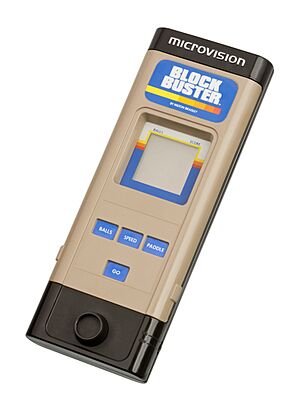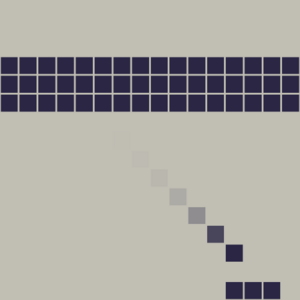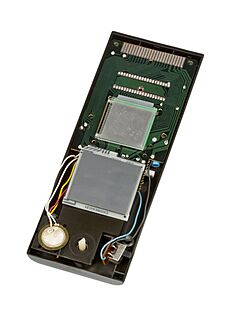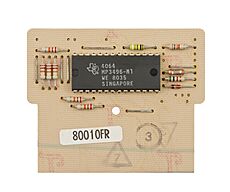Microvision facts for kids

A Microvision with Block Buster cartridge inserted
|
|
| Also known as | Milton Bradley Microvision MB Microvision |
|---|---|
| Manufacturer | Milton Bradley Company |
| Type | Handheld game console |
| Generation | Second generation |
| Release date | November 1979 |
| Introductory price | US$49.99 (equivalent to about $202 in 2022) |
| Discontinued | 1981 |
| Media | ROM cartridges |
| Power | 1 × 9V battery (TMS1100 processors), 2 × 9V battery (Intel 8021 processors) |
| CPU | Intel 8021/TI TMS1100 (on cartridge) clocked at 100 kHz |
| Memory | 64 bytes RAM, 2K ROM |
| Display | 16 × 16 pixels resolution |
The Microvision was the very first handheld game console that let you swap out games using different cartridges. This meant you could play many different games on one device! It was released by the Milton Bradley Company in November 1979. It cost about $50 back then, which would be around $212 today.
Jay Smith, who later created the Vectrex console, designed the Microvision. People liked that it was portable and had changeable games. This helped Smith Engineering make $15 million in its first year! However, not many games were made for it, the screen was small, and bigger game companies didn't support it. Because of these reasons, the Microvision stopped being made in 1981. Interestingly, Satoru Okada, a former head at Nintendo, said the Microvision helped inspire the Game Boy. Nintendo learned from the Microvision's limits to make their own famous handheld.
Contents
How the Microvision Was Made
Most game consoles have their main brain, called the CPU, built right inside. But the Microvision was different! Each game cartridge actually held its own CPU. This meant the console itself was mostly just the controls, the screen, and the screen's controller.
The first Microvision games used processors from both Intel 8021 and Texas Instruments TMS1100. Later, Milton Bradley decided to use only the TMS1100 processors. They even reprogrammed older games to work with this new processor. The TMS1100 was simpler but used less power and had more memory.
Early Microvisions needed two 9-volt batteries because the Intel 8021 processor used a lot of power. Newer units, designed for the TMS1100, only needed one battery. There was a safety issue with the two-battery design. If one battery was put in the wrong way, it could cause a short circuit and make the batteries overheat. To fix this, Milton Bradley removed the connections for one of the battery slots. They still kept the empty space but called it a "spare battery holder."
Common Problems with the Microvision
Microvision consoles and games are quite rare today. The ones that still exist often have three main problems: "screen rot," damage from ESD, and issues with the keypad.
Screen Rot
The screens on the Microvision were made with older technology. Because of poor sealing and tiny bits of dirt during manufacturing, the liquid inside the screen could leak. When this happened, the screen would permanently darken in spots. This is called screen rot. The game might still work, but you couldn't see the picture clearly. While you could avoid extreme heat (like leaving it in the sun), which would instantly ruin the screen, there was no way to stop screen rot from happening over time in most Microvision systems.
ESD Damage
A big problem with early Microvision units was that the microprocessor (inside each game cartridge) wasn't protected from static electricity. The processor was directly connected to the metal pins that link the cartridge to the console. If a user touched these pins while carrying a static charge, the charge could jump to the processor. Even a small static shock, too tiny for a person to feel, could destroy the delicate parts inside the cartridge.
John Elder Robison, a former Milton Bradley engineer, wrote about this problem. He said that during the 1979 holiday season, up to 60% of units were returned because they were broken by static electricity! This caused a lot of worry at Milton Bradley. They had to make big changes to later Microvision units and their factories to help prevent static charges.
Keypad Problems
The Microvision had a twelve-button keypad hidden under a thick, flexible plastic layer. Each game cartridge had cutouts that fit over the keypad. A thin piece of printed plastic was placed over these cutouts to show what each button did for that specific game.
The problem was that pressing the buttons would stretch this thin plastic. Over time, it would tear. Having long fingernails made this problem worse. Also, many early games were programmed to react when a key was released, not when it was pressed. This meant players might press harder because they didn't feel an immediate response, which also made the plastic tear faster.
Technical Details
- Brain (CPU): Intel 8021 or TI TMS1100 (found inside the game cartridge)
- Screen: A 16x16 pixel LCD screen
- Speed: 100 kHz (kilohertz)
- Memory (RAM): 64 bytes (built into the CPU)
- Game Memory (ROM): 2K (TMS100) or 1K (8021) (also built into the CPU of each game)
- Sound: A simple beeper
- Controls: A twelve-button keypad and one paddle
- Power: One or two 9-volt batteries, depending on the console version
Games for Microvision
In the USA, the game cartridges were beige. But in Europe, they came in many different colors! The games were also numbered on their boxes in Europe. The Microvision was advertised for players aged 8 to 80.
There were 12 games known to have been released for the Microvision.
- Background shading indicates canceled games.
| # | US title | Overseas titles | Release date | Processor |
|---|---|---|---|---|
| 1 | November 1979 | TI MP3450A | ||
| 2 | November 1979 | TI MP3475NLL | ||
| 3 | November 1979 | Signetics Intel 8021 TI MP3481NLL |
||
| 4 | November 1979 | TI MP3455NLL | ||
| 5 | N/A | 1979 | TI MP3457NLL | |
| 6 | (later just Phaser Strike) |
1979 | TI MP3454NLL | |
| 7 | N/A | 1979 | TI MP3474-NLL | |
| 8 | N/A | 1980 | TI MP3479-N1NLL | |
| 9 | 1980 | TI MP3496-N1 | ||
| 10 | 1981 | TI M34009-N1 | ||
| 11 | N/A | 1981 | TI M34007-N1 | |
| 12 | N/A | 1982 | TI M34047-N2LL | |
| 13 | Barrage | ? | Unreleased (was planned for 1982) |
? |
Reviews
- 1980 Games 100 in Games
- 1981 Games 100 in Games
See also
- Mattel Auto Race
- Vectrex




